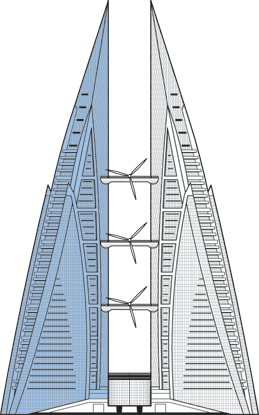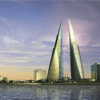Filter by

Bahrain World Trade Center
Complex
Completed
office
Note: Only buildings that have GPS coordinates recorded are displayed.
|
RANK
|
Name
|
Completion
|
Height
|
Floors
|
Function
|
|---|---|---|---|---|---|
| 1 | Bahrain World Trade Center 1 | 2008 |
240 m / 787 ft |
45 | Office |
| 1 | Bahrain World Trade Center 2 | 2008 |
240 m / 787 ft |
45 | Office |
2008 CTBUH Awards
22 September 2010 - Event
2 March 2008 - Event

19 September 2012
In sharp contrast to traditional motion control devices, this session presents a unique method of converting vibration energy into electricity while concurrently providing structure response...

05 March 2008
Shaun Killa & Richard F. Smith, W S Atkins & Partners Overseas
This paper describes the design evolution of the large scale wind turbines proposed for the Bahrain Trade Center. It describes the details of the wind...

19 September 2012
In sharp contrast to traditional motion control devices, this session presents a unique method of converting vibration energy into electricity while concurrently providing structure response...

03 March 2009
Shaun Killa from WS Atkins, described the design evolution of the large scale wind turbines proposed for the Bahrain Trade Center. The presentation also highlighted...

20 November 2008
Shaun Killa, of Atkins Middle East, is interviewed by Jeff Herzer prior to the 7th CTBUH Annual Awards Dinner at the CTBUH headquarters, Iliinois Institute...

05 March 2008
Shaun Killa & Richard F. Smith, W S Atkins & Partners Overseas
This paper describes the design evolution of the large scale wind turbines proposed for the Bahrain Trade Center. It describes the details of the wind...

02 November 2007
Richard F. Smith & Shaun Killa, W. S. Atkins & Partners Overseas
This paper describes the design evolution of the large-scale wind turbines proposed for the Bahrain Trade Center. It will describe the details of the wind...
27 September 2010
The local CTBUH Qatar Chapter organized their 2nd regional meeting, while CTBUH Communications Manager Jan Klerks was invited to speak at TowerTech trade fair in Doha.
Subscribe below to receive periodic updates from CTBUH on the latest Tall Building and Urban news and CTBUH initiatives, including our monthly newsletter. Fields with a red asterisk (*) next to them are required.
View our privacy policy